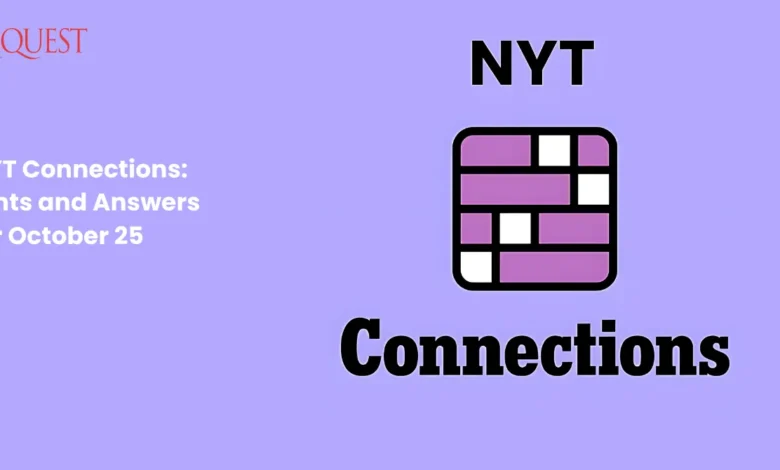NYT Connections Hints: Tips and Tricks to Master the Game

The New York Times’ “Connections” is a popular word puzzle game that has quickly captivated the minds of puzzle enthusiasts. For fans of word games ,NYT Connections Hints offers a fresh and engaging challenge where players must group together words that are related in some way. However, it’s not always easy to spot the connections, and sometimes you might find yourself scratching your head, wondering how to crack the puzzle. That’s where NYT Connections hints come in handy.
This article will provide you with insights, tips, and strategies to help you navigate the game, recognize patterns, and improve your gameplay. Whether you’re a beginner or a seasoned player, these hints will help you solve the puzzles more effectively and make your experience more enjoyable. NYT Connections Hints
What is NYT Connections?
NYT Connections is a daily puzzle game by The New York Times where players are presented with a grid of 16 words. The objective is to find four groups of four words that are linked by a common NYT Connections Hints theme or category. It’s a fun mix of word association, vocabulary, and pattern recognition, making it a delightful mental exercise. NYT Connections Hints
Each day, the puzzle introduces new words, and the connections between them can range fromNYT Connections Hintsobvious (like colors or animals) to more abstract associations (like phrases, synonyms, or pop culture references). NYT Connections Hints

How to Play NYT Connections
- Examine the Grid: You’ll see a 4×4 grid filled with 16 words. NYT Connections Hints
- Find Groups of Four: Identify four words that share a common link. NYT Connections Hints
- Guess and Confirm: Once you think you’ve found a group, select all four words. If they are indeed connected, they’ll be highlighted as a group. If not, try again! NYT Connections Hints
- Repeat Until Complete: Continue until you’ve identified all four groups. NYT Connections Hints
The game starts with unlimited guesses, but your goal should be to solve the puzzle without making too many wrong attempts. The fewer mistakes, the better your score. NYT Connections Hints
Understanding the Types of Connections
Before diving into the hints, it’s essential to know the kinds of connections you might encounter. Here are some common themes: NYT Connections Hints
- Categories: Like fruits, colors, cities, animals,NYT Connections Hints
- Synonyms/Antonyms: Words that have similar or opposite meanings.
- Wordplay: Puns, homonyms, or words that sound alike. NYT Connections Hints
- Phrases or Expressions: Words that commonly appear together.
- Pop Culture References: Groups that relate to movies, TV shows, music, or famous personalities.
NYT Connections Hints and Strategies
Now, let’s explore some helpful hints to master the game: NYT Connections Hints
1. Start With the Obvious Groups
When you first look at the grid, try to find any group that immediately stands out. For example, if you see four colors (like red, blue, green, and yellow), it’s safe to assume they form a group. Identifying the easier groups first can help clear the grid and make the remaining connections easier to spot. NYT Connections Hints
2. Look for Synonyms and Related Words
Some puzzles rely on words that are similar in meaning. For instance, words like “happy,” “joyful,” “elated,” and “content” could form a group. Similarly, you might find words that are opposites, such as “big” and “small,” hinting at a possible connection. NYT Connections Hints
3. Identify Uncommon Words
If there are words you don’t recognize, it might be worth looking them up. Often, the game will use less common words that fit a theme you might not have considered. Expanding your vocabulary can help you identify connections you might otherwise miss. NYT Connections Hints
4. Consider Different Meanings of Words
Some words might have multiple meanings, and the game often plays on that ambiguity. For example, “bark” could refer to a tree’s covering or the sound a dog makes. If you see other words like “leaf,” “branch,” and “root,” you might be looking at a theme related to trees.
5. Group Words Based on Wordplay
Sometimes, the connections are more playful. Words that sound alike, such as “knight” and “night,” might form a group. You’ll need to think outside the box and consider puns, homophones, or words that fit well together phonetically.
6. Don’t Be Afraid to Make Guesses
The game encourages you to think and experiment. If you’re unsure but have a hunch, go ahead and guess. There’s no penalty for trying out different combinations, and sometimes the process of elimination can help you zero in on the correct groups.
7. Work Backwards From the Harder Words
If you’ve cleared two or three groups and are stuck on the last few words, try to see how they might connect with each other. Sometimes working backward from the hardest part of the puzzle can reveal a connection you didn’t see before.
Examples of Common Connection Themes
To give you a better idea of how to approach these puzzles, here are a few examples of typical themes you might find in NYT Connections:
- Food Items: Words like “apple,” “bread,” “pasta,” and “cheese” might form a group.
- Geographical Locations: Cities, countries, or landmarks, such as “Paris,” “London,” “Rome,” and “Tokyo.”
- Types of Animals: “Lion,” “tiger,” “bear,” “elephant.”
- Occupations: “Doctor,” “teacher,” “engineer,” “pilot.”
- Colors: “Red,” “blue,” “green,” “yellow.”
- Famous Movies or TV Shows: “Friends,” “Breaking Bad,” “Seinfeld,” “The Office.”
Daily Strategies for Consistent Success
1. Practice Makes Perfect
Like any puzzle game, the more you play, the better you get. As you familiarize yourself with common themes and word associations, you’ll find that spotting connections becomes easier over time.
2. Expand Your Knowledge Base
NYT Connections occasionally pulls from a wide range of categories, including history, literature, pop culture, and science. The more you know, the better equipped you’ll be to identify connections. So keep learning new things!
3. Stay Calm and Enjoy the Game
Don’t get too frustrated if you’re stuck. Sometimes taking a break and returning to the puzzle with fresh eyes can make all the difference. Remember, it’s all about enjoying the process of solving the puzzle.
Why People Love NYT Connections
So, why has NYT Connections become such a hit? It combines the thrill of word puzzles with the satisfaction of solving a riddle. Players get to test their vocabulary, trivia knowledge, and problem-solving skills. Plus, there’s a delightful sense of accomplishment when you finally crack that last tricky group!
Moreover, the game can be a great way to exercise your brain, improve your language skills, and even learn new things. It’s a perfect blend of fun and learning that appeals to a wide audience, from casual players to hardcore puzzle lovers.
Conclusion: Mastering NYT Connections with Hints and Practice
NYT Connections is more than just a word puzzle—it’s a fun way to sharpen your mind, expand your vocabulary, and challenge yourself daily. By using these hints and strategies, you’ll find yourself improving your skills and solving puzzles more efficiently. The key is to practice regularly, think creatively, and enjoy the journey of discovering how words connect.
So, next time you sit down to play, keep these tips in mind, and watch as you master the art of connections. Happy puzzling!
Conclusion
What is NYT Connections? NYT Connections is a daily word puzzle game where players group together 16 words into four related groups of four words each. The goal is to identify the connections between the words to solve the puzzle.
How can I improve my gameplay in NYT Connections? Start by identifying the obvious groups, use the process of elimination, and don’t be afraid to guess. Expanding your vocabulary and thinking about multiple meanings of words can also help.
Are there penalties for wrong guesses in NYT Connections? No, there are no penalties for wrong guesses. You can try different combinations until you find the correct groups.
Can I play NYT Connections for free? Yes, NYT Connections is available on The New York Times website, and there are both free and subscription-based puzzles available.
What are some common themes in NYT Connections puzzles? Themes can vary widely but often include categories like animals, colors, professions, famous people, and common phrases.
Why are hints useful in NYT Connections? Hints help players see patterns they might not have noticed and guide them to think creatively about word associations, making it easier to solve puzzles quickly and accurately.


